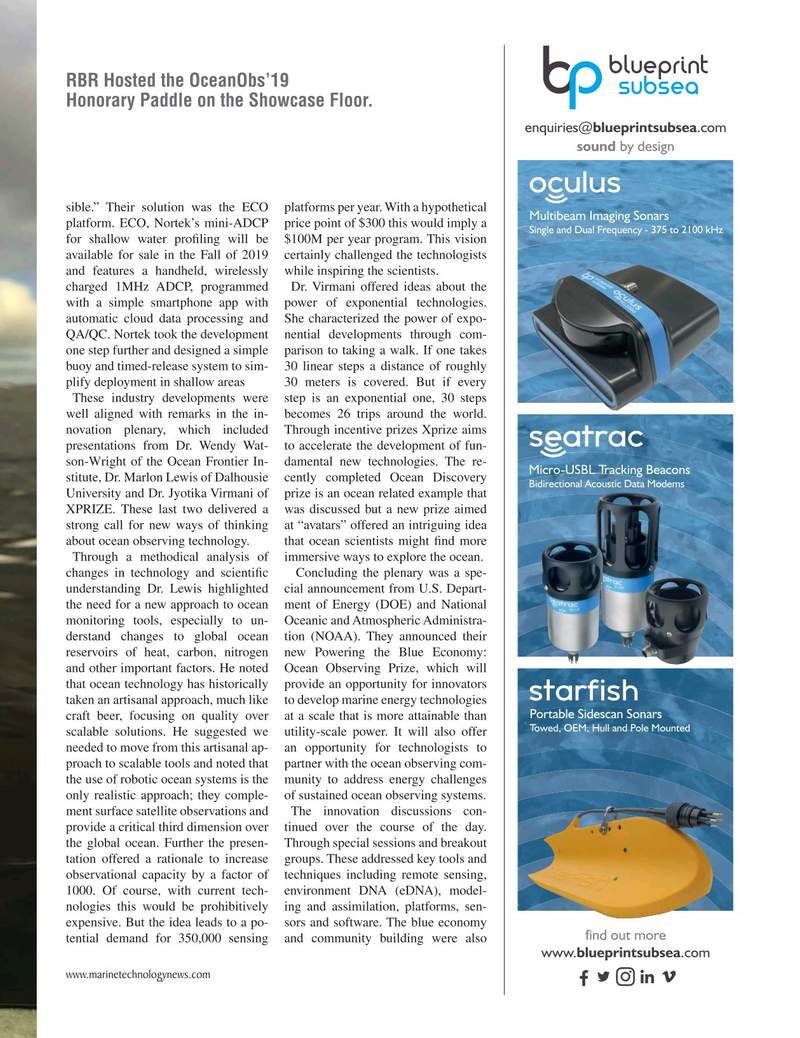
Page 37: of Marine Technology Magazine (October 2019)
Ocean Observation: Gliders, Buoys & Sub-Surface Networks
Read this page in Pdf, Flash or Html5 edition of October 2019 Marine Technology Magazine
RBR Hosted the OceanObs’19
Honorary Paddle on the Showcase Floor.
HQTXLULHV#EOXHSULQWVXEVHDFRP
VRXQGE\GHVLJQ sible.” Their solution was the ECO platforms per year. With a hypothetical 0XOWLEHDP,PDJLQJ6RQDUV platform. ECO, Nortek’s mini-ADCP price point of $300 this would imply a 6LQJOHDQG'XDO)UHTXHQF\WRN+] for shallow water pro? ling will be $100M per year program. This vision available for sale in the Fall of 2019 certainly challenged the technologists and features a handheld, wirelessly while inspiring the scientists. charged 1MHz ADCP, programmed Dr. Virmani offered ideas about the with a simple smartphone app with power of exponential technologies. automatic cloud data processing and She characterized the power of expo-
QA/QC. Nortek took the development nential developments through com- one step further and designed a simple parison to taking a walk. If one takes buoy and timed-release system to sim- 30 linear steps a distance of roughly plify deployment in shallow areas 30 meters is covered. But if every
These industry developments were step is an exponential one, 30 steps well aligned with remarks in the in- becomes 26 trips around the world. novation plenary, which included Through incentive prizes Xprize aims presentations from Dr. Wendy Wat- to accelerate the development of fun- son-Wright of the Ocean Frontier In- damental new technologies. The re- 0LFUR86%/7UDFNLQJ%HDFRQV stitute, Dr. Marlon Lewis of Dalhousie cently completed Ocean Discovery %LGLUHFWLRQDO$FRXVWLF'DWD0RGHPV
University and Dr. Jyotika Virmani of prize is an ocean related example that
XPRIZE. These last two delivered a was discussed but a new prize aimed strong call for new ways of thinking at “avatars” offered an intriguing idea about ocean observing technology. that ocean scientists might ? nd more
Through a methodical analysis of immersive ways to explore the ocean. changes in technology and scienti? c Concluding the plenary was a spe- understanding Dr. Lewis highlighted cial announcement from U.S. Depart- the need for a new approach to ocean ment of Energy (DOE) and National monitoring tools, especially to un- Oceanic and Atmospheric Administra- derstand changes to global ocean tion (NOAA). They announced their reservoirs of heat, carbon, nitrogen new Powering the Blue Economy: and other important factors. He noted Ocean Observing Prize, which will that ocean technology has historically provide an opportunity for innovators taken an artisanal approach, much like to develop marine energy technologies 3RUWDEOH6LGHVFDQ6RQDUV craft beer, focusing on quality over at a scale that is more attainable than 7RZHG2(0+XOODQG3ROH0RXQWHG scalable solutions. He suggested we utility-scale power. It will also offer needed to move from this artisanal ap- an opportunity for technologists to proach to scalable tools and noted that partner with the ocean observing com- the use of robotic ocean systems is the munity to address energy challenges only realistic approach; they comple- of sustained ocean observing systems.
ment surface satellite observations and The innovation discussions con- provide a critical third dimension over tinued over the course of the day. the global ocean. Further the presen- Through special sessions and breakout tation offered a rationale to increase groups. These addressed key tools and observational capacity by a factor of techniques including remote sensing, 1000. Of course, with current tech- environment DNA (eDNA), model- nologies this would be prohibitively ing and assimilation, platforms, sen- expensive. But the idea leads to a po- sors and software. The blue economy
ILQGRXWPRUH tential demand for 350,000 sensing and community building were also
ZZZEOXHSULQWVXEVHDFRP www.marinetechnologynews.com
MTR #8 (34-49).indd 37 10/8/2019 9:09:41 AM

 36
36

 38
38
